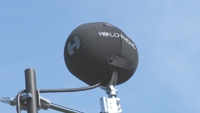Holophone's H2-PRO
TV Azteca is one of the largest producers of Spanish-language programming. We currently produce the content for two major Mexican television Networks, Azteca 13 and Azteca 7. As of the third quarter this year, both networks are transmitting in full HD.
To lead into the HD coverage of the FIFA World Cup in Germany and the commencement of complete HD transmission, we planned to transmit the Federación Mexicana de Futbol (the First Division of Mexico's professional soccer league) games in HD and surround sound. We decided that Holophone's H2-PRO surround microphone was the best choice for our needs, as it has been used for previous live broadcasts across the globe with exemplary results.
Realistic sound capture
For a typical game setup, one H2-PRO is placed at the back of the stadium parallel with the halfway line to capture the ambient sound of the field and the fans. After the mic is placed, no additional adjustments are needed; just plug its eight XLR microphone connectors into the monitor, and it is ready to use. To capture the same quality and range of sound without a surround microphone, multiple microphones would need to be positioned around the stadium, which would add additional time to the pre-game setup.
One of the major criterions in selecting a microphone was that viewers would receive true-to-life sounds that matched whatever camera angle we selected. Hearing the different sounds of the game — whether it is fans playing trumpets to show team spirit or the crowd's reaction to on-field action — is just as important to the live experience as seeing each exciting play. From one microphone, we are able to capture realistic perception of volume and proper perspective for any camera angle. With the average game having 12 to 14 cameras, this is not a small feat. The eight mic elements enclosed in the mic capsule along with its elliptical shape mimics the way a human head receives sound, providing realistic sound reproduction.
No mixing necessary
Another timesaver is that no additional mixing, signal manipulation or processing of the ambient sound is needed. The discrete signal is sent directly from the mic to the monitor. For live television, where everything is happening so quickly and there's not a lot of time for adjustment, the mic is able to do its job with very little tweaking during the game. If we were using a multi-mic setup to capture surround sound, we would need to regularly adjust the mix coming in to create a similar sound to that received from one surround microphone.
The professional video industry's #1 source for news, trends and product and tech information. Sign up below.

In addition to the H2-PRO, we use several other types of mics for game coverage. We use headsets with microphones for the play-by-play commentary, as well as reporters on the field, on the benches and other locations throughout the stadium. All of these signals are mixed and then added into the central channel with a little bit of a split into the left or right channel.
To supplement the sounds the H2-PRO picks up from the field, we have boom microphones behind the goals, in the corners, at the middle of the field and along each side of the field. The booms follow the cameras at field level to reinforce players kicking the ball, especially when they are executing a corner kick or taking a penalty shot. Most of the sounds captured by these microphones are put on the left and right and front channel but never used for the background. The background channel is always the H2-PRO.
Technology transcends sports
Due to its ease of use and sound quality, Holophone's H2-PRO has become the standard for surround recording on both networks. All current and incoming crew members are being trained in the use of the surround microphone.
Our staff is in charge of producing most of the programming seen on the station from news coverage, to game shows and soap operas, so having a technology that's easy to use and requires minimal training is helping make the switch to HD seamless. In addition to using the mic for sports coverage, we are using it for on-location shoots of soap operas. We also have plans to use it to capture audience reactions for the game shows we produce. Further, with camera-mountable mics in the works, we will soon have surround sound in ENG situations for our news broadcasts.
Audio quality matters
HD viewers demand sound that matches the high-quality images they see. Broadcasters are looking to meet this need, but multi-mic setups to capture surround sound is often time-consuming and costly. Using a surround microphone gives your viewers the sound they are looking for with minimal setup time, ensuring that you and your viewers don't miss a moment of the action.
Jorge Pickering is the director of technical services for TV Azteca.
